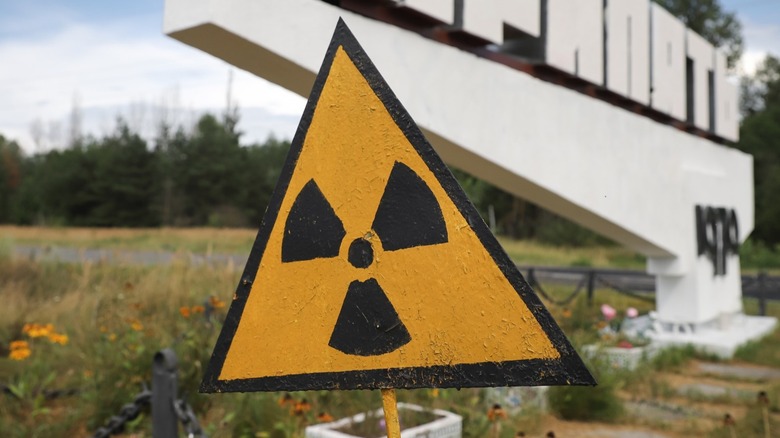How Russian Military Activity In The Chernobyl Exclusion Zone Could Have Far-Reaching Effects
Chernobyl, which is currently a town in the north of Ukraine, is infamous for the largest nuclear disaster in history when the town's nuclear power plant suffered a meltdown on April 26, 1986. A subsequent explosion and then ongoing open-air reactor core fire released massive amounts of radiation into the surrounding town and across the former USSR and western Europe. As Live Science notes, 31 people died in the immediate aftermath of the disaster including many emergency workers who heroically knowingly exposed themselves to fatal levels of radiation to help put out the fire. Further, between the years of 1991 and 2015 around 20,000 cases of thyroid cancer were diagnosed in patients who were under the age of 18 and exposed to the disaster at the time.
Following the containment of the Chernobyl nuclear disaster, the Chernobyl Exclusion Zone was established around the nuclear plant with a radius of 30 kilometers (18.6 miles). As the International Atomic Energy Agency explains, some of the town's residents have returned to their homes and now live in areas with "higher than normal" levels of radiation.
The lives of Chernobyl's residents were placed at direct risk of harm once more here in the year 2022. This time the threat was not from nuclear meltdown, but from a Russian military invasion, a so-called "Battle of Chernobyl" on February 22, 2022, and a Russian troop presence that followed the battle. Here in early March, 2022, Russian forces have control of both the town and the reactor site.
The fallout from battle
Russian and Belarusian forces entered the Chernobyl Exclusion Zone through Belarus, a Russian allied country located on the northern border of Ukraine. Entry at this point is just 90 kilometers (60 miles) north of Kyiv, the capital city of Ukraine, and presents most direct route to Kyiv from Belarus.
The abandoned reactor's industrial area also acts as a good staging area for launching an attack as many hundreds or thousands of vehicles can be parked on the site. But as Phys Org also explains, sensors placed in the Chernobyl Exclusion Zone by the Ukrainian Chernobyl EcoCenter to monitor conditions in case of fires or accidents detected substantial jumps in radiation levels following the entry of Russian and Belarussian forces into the area.
Unfortunately, the sensor system is no longer functional thanks to military activity in the area. The explanation for this is that troop and artillery activity will have kicked up dust that contains radioactive contaminants including cesium137, strontium-90, plutonium, uranium and americium-241 (all of which are known as radionuclides). According to Phys Org, all are toxic and carcinogenic if inhaled.
This means that soldiers from both sides as well as Ukrainian civilians and workers in the area have been potentially exposed to radionuclides. Similarly, flora and fauna in the area could once again suffer the ill effects of radiation exposure too. The Chernobyl disaster may've been effectively contained over the past couple of decades, but its lingering ill effects could once again rear their ugly head.
